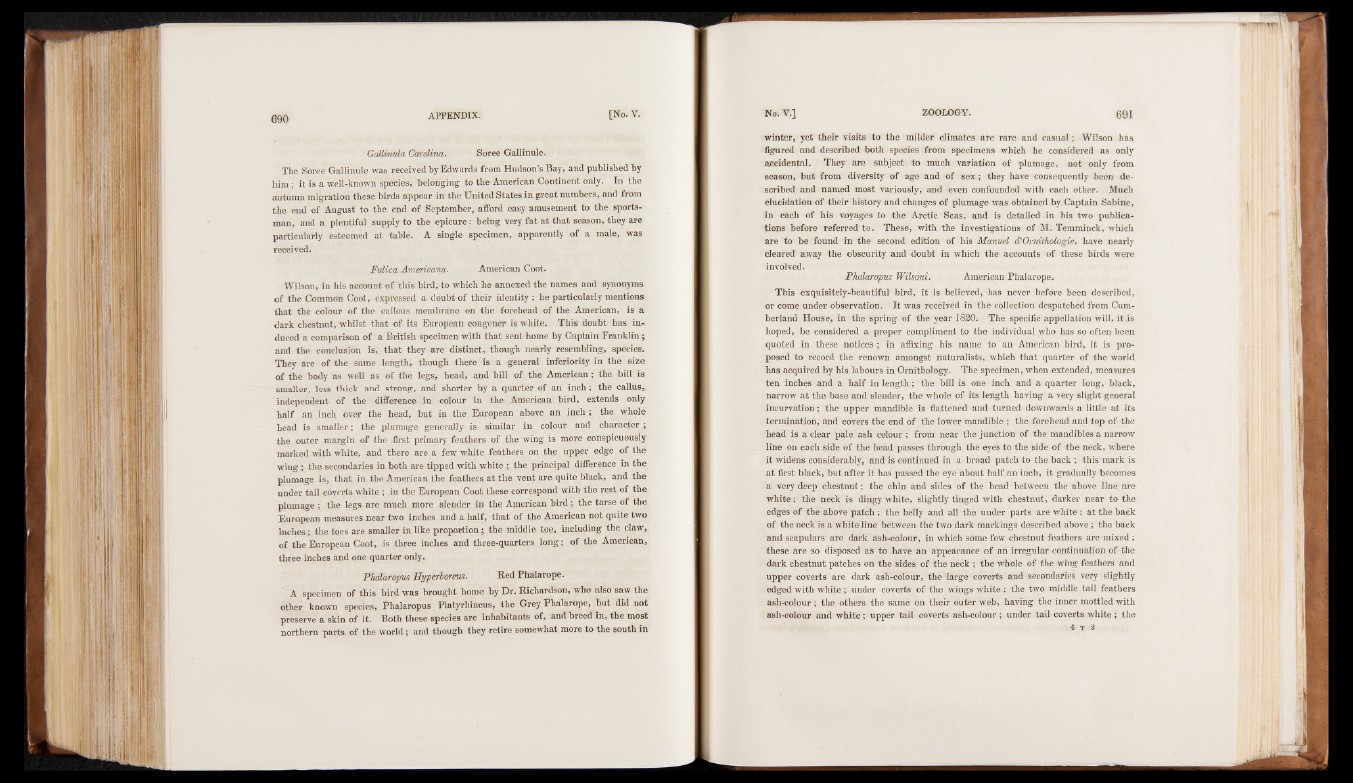
Gallinvla Carolina. Soree Gallinule.
The Soree Gallinule was received by Edwards from Hudson’s Bay, and published by
him ; it is a well-known species, belonging to the American Continent only. In the
autumn migration these birds appear in the United States in great numbers, and from
the end of August to the end of September, afford easy amusement to the sportsman,
and a plentiful supply to the epicure: being very fat at that season, they are
particularly esteemed at table. A single specimen, apparently of a male, wa£
received.
Fvlica Americana. American Coot.
Wilson, in his account of this bird, to which he annexed the names and synonyms
of the Common Coot, expressed a doubt of their identity ; he particularly mentions
that the colour of the callous membrane on the forehead of the American, is a
dark chestnut, whilst that of its European congener is white. This doubt has induced
a comparison of a British specimen with that sent home by Captain Franklin;
and the conclusion is, that they are distinct, though nearly resembling, species.
They are of the same length, though there is a general inferiority in the size
of the body as well as of the legs, head, and bill of the American; the bill is
smaller, less thick and strong, and shorter by a quarter of an inch; the callus,
independent of the difference in colour in the American bird, extends only
half an inch over the head, but in the European above an inch ; the whole
head is smaller; the plumage generally is similar in colour and character ;
the outer .margin of the first primary feathers of the wing is more conspicuously
marked with white, and there are a few white feathers on the upper edge of the
wing; the secondaries in both are tipped with white ; the principal difference in the
plumage is, that in the American the feathers at the vent are quite black, and the
under tail coverts white ; in the European Coot these correspond with the rest of the
plumage ; the legs are much more slender in the American bird; the tarse of the
European measures near two inches and a half, that of the American not quite two
inches; the toes are smaller in like proportion; the middle toe, including the claw,
of the European Coot, is three inches and three-quarters long; of the American,
three inches and one quarter only.
Phalaropus Hyperboreus. Red Phalarope.
A specimen of this bird was brought home by Dr. Richardson, who also saw the
other, known species, Phalaropus Platyrhincus, the Grey Phalarope, but did not
preserve a skin of it. Both these species are inhabitants of, and breed in, the most
northern parts of the world; and though they retire somewhat more to the south in
winter, yet their visits to the milder climates are rare and casual; Wilson has
figured and described both species from specimens which he considered as only
accidental. They are subject to much variation of plumage, not only from
season, but from diversity of age and of sex; they have consequently been described
and named most variously, and even confounded with each other. Much
elucidation of their history and changes of plumage was obtained by Captain Sabine,
in each of his voyages to the Arctic Seas, and is detailed in his two publications
before referred to. These, with the investigations of M. Temminck, which
are to be found in the second edition of his Manuel d'Ornithologies have nearly
cleared away the obscurity and doubt in which the accounts of these birds were
involved. Phalaropus Wilsoni. American Phalarope.
This exquisitely-beautiful bird, it is believed, has never before been described,
or come under observation. It was received in the collection despatched from Cumberland
House, in the spring of the year 1820. The specific appellation will, it .is
hoped, be considered a proper compliment to the individual who has so often been
quoted in these notices ; in affixing his name to an American bird, it is proposed
to record the renown amongst naturalists, which that quarter of the world
has acquired by his labours in Ornithology. The specimen, when extended, measures
ten inches and a half in length; the bill is one inch and a quarter long, black,
narrow at the base and slender, the whole of its length having a very slight general
incurvation; the upper mandible is flattened and turned downwards a little at its
termination, and covers the end of the lower mandible ; the forehead and top of the
head is a clear pale ash colour ; from near the junction of the mandibles a narrow
line on each side of the head passes through the eyes to the side of the neck, where
it widens considerably, and is continued in a broad patch to the back ; this mark is
at first black, but after it has passed the eye about half an inch, it gradually becomes
a very deep chestnut; the chin and sides of the head between the above line are
white; the neck is dingy white, slightly tinged with chestnut, darker near to the
edges of the above patch ; the belly and all the under parts are white; at the back
of the neck is a white line between the two dark markings described above ; the baek
and scapulars are dark ash-colour, in which some few chestnut feathers are mixed ;
these are so disposed as to have an appearance of an irregular continuation of the
dark chestnut patches on the sides of the neck ; the whole of the-wing feathers and
upper coverts are dark ash-colour, the large coverts and secondaries very slightly
edged with white; under coverts of the wings white ; the two middle tail feathers
ash-colour ; the others the same on their outer web, having the inner mottled with
ash-colour and white; upper tail coverts ash-colour; under tail coverts white ; the